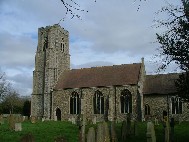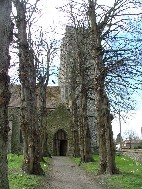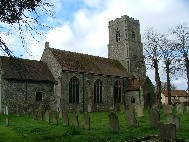| |
|
St Peter
and St Paul, Griston
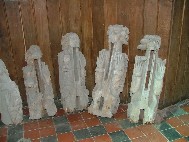 |
|
From
the map, you might think that Griston was almost
a suburb of Watton. But it is separated from that
pretty little town by the former RAF airbase, and
to reach Griston you must travel out into the
countryside. The airbase is now home to one of
Her Majesty's Prisons, and Griston is curtailed
beyond, along a road that leads to nowhere else.
This makes it a particularly quiet spot, and it
was a delight to stand in the graveyard listening
to spring birdsong. St Peter
and St Paul has a magnificent tower of the 14th
century, and the church beside it, which was
rebuilt a hundred years later, appears rather
austere and bleak beside it, as if professing
Perpendicular rationalism against the mystery of
its Decorated tower.
|
A long
avenue of limes leads to the north doorway. Peter had
previously found this church locked, and it looked locked
today; but, as it would turn out, there was a very good
reason for this. As we approached, we found ourselves
following a man up the path. He unlocked the door and
went in. Hopefully, we followed him into the church.
He turned
out to be the churchwarden, and here, leaning against the
west wall of the nave, were the reasons that the church
was currently being kept locked. They are angels, from
the 15th century hammerbeam roof which was dismantled and
replaced by the Victorians. They retained some of the
smaller figures, but the larger ones were consigned to
the floor of the belfry, where they were left to rot for
more than a century. Just recently, they had been
rediscovered, and brought down to the church. They have
been examined by experts, and are to be restored at
fabulous cost.
They are
stunning, these ghosts of medieval Norfolk. The curly
hair is familiar from contemporary stained glass. Two of
them hold symbols, one a bag and the other a chalice and
host. The restoration adviser had suggested that the
figure holding a bag might be St Matthew, which might
mean the chalice actually had a disc with a painting of a
dragon on it, making that figure St John. But looking at
the photographs since, I think they must all be angels.
It is planned to reset them at angles where the
hammerbeam ends would have been.
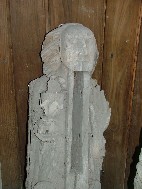 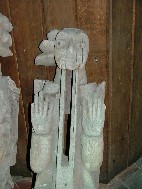 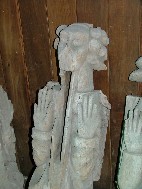
The churchwarden told us that he had
assumed, on entering the church for the first time, that
it was all of its 19th century restoration, and I must
admit that this was also my own first impression. But
even without the angels there are some excellent medieval
survivals here. Most significant is a group of four Old
Testament Patriarchs and Prophets in stained glass, a
very rare thing to find. They are David, Jeremiah,
Isaiah, and Noah. In medieval times, each of them would
have been paired with a Disciple.
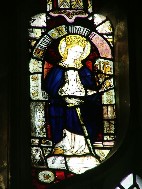 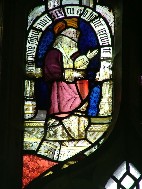 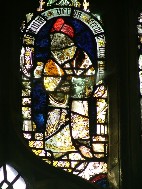 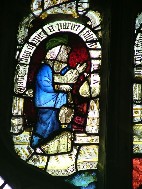 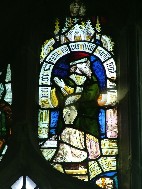
The narrow
lights beside them contain censing angels and a bishop,
but one of the larger lights contains a 15th century
figure of St Catherine with her wheel and sword. Mortlock
says that this was reset here at the time of the 1885
restoration, suggesting that the Victorians thought it a
more valuable piece than the angels.
Mortlock
also encourages us to look at the 17th century communion
rail, with its unusual indent. As he points out, it is
identical to that at Thompson, across the fields, and
must be the work of the same hand. This reminds us that
such furnishings were usually the work of a local man.
Above hangs the Stars and Stripes, a reminder of the
wartime use of the local base. Churches have become a
powerful symbol in the memory of those who flew from the
East Anglian bases. As one old man told me a few years
back: "the church tower was the last thing we saw
after we'd left the ground, and when we saw it again we
knew we'd made it home".
As well as
rebuilding the roof, the 19th century restoration gave
the church a new floor, a sprawl of vitreous tiles, and
most of the furnishings. This creates a rather gloomy
interior, especially as the windows are not clear, but
this creates a good foil for the view east, through a
delicate 14th century screen and the contemporary
reticulated tracery in the window. On this sunny morning
it was a joyful sight.
| Back
at the west end, on the front of the ringing
gallery is a royal arms dated 1902. I was excited
to think that this must be a set for Edward VII,
making them unique in East Anglia. It appears to
be cast iron, although it was rather high up to
be sure. However, Bryan Kitson points out that
thay are, in fact, the arms of Hanover, merely
redated. Beneath, the font is a fairly
perfunctory late medieval octagonal one, except
that to it has been added a most unusual
inscription referring to the restoration of the
tower in 1568:at that date was tys Steple
tope newe set up to the great cost of landed men.
This must refer to the battlements, and the
phrase great cost means that they bore
the larger part of it rather than that it was
fabulously expensive. Even so, they've made sure
that we don't forget.
|
|
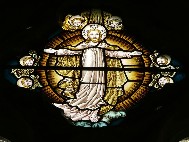 |
|
|
|


